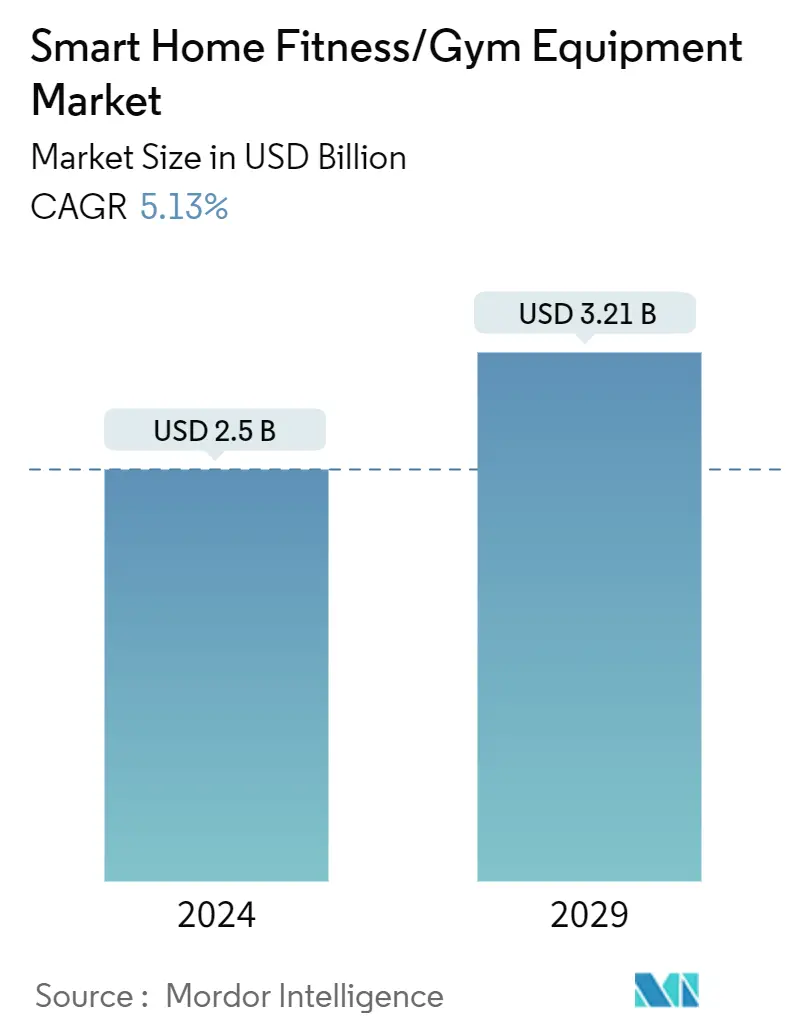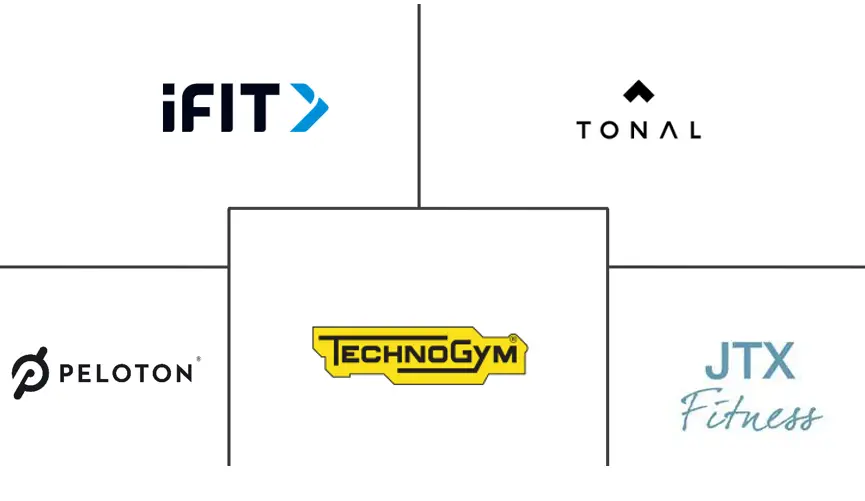Market Size of Smart Home Fitness/Gym Equipment Industry

| Study Period | 2020-2029 |
| Market Size (2024) | USD 2.5 Billion |
| Market Size (2029) | USD 3.21 Billion |
| CAGR (2024 - 2029) | 5.13 % |
| Fastest Growing Market | Asia Pacific |
| Largest Market | North America |
| Market Concentration | Low |
Major Players
*Disclaimer: Major Players sorted in no particular order |
Smart Home Fitness/Gym Equipment Market Analysis
The Smart Home Fitness/Gym Equipment Market size is estimated at USD 2.5 billion in 2024, and is expected to reach USD 3.21 billion by 2029, growing at a CAGR of 5.13% during the forecast period (2024-2029).
Smart home fitness equipment encompasses devices or machines that allow consumers to exercise at home, thus enhancing their muscle strength, endurance, and weight management. These devices offer a heightened level of engagement, featuring vast libraries of guided sessions that are led by skilled instructors and personalized workouts. These programs are tailored to individual goals and fitness levels. Essentially, they provide the experience of having a personal trainer at home, offering convenience, safety, and privacy. Treadmills, stationary bikes, stair climbers, rowing machines, and ellipticals rank among the favored smart home workout equipment options.
The home fitness equipment market has experienced significant growth in recent years, which is projected to continue. This surge can be credited to various factors, such as the convenience of having exercise tools at home and a rising understanding of the benefits of consistent physical activity. The COVID-19 pandemic increased demand for home workout gear as people shifted to remote work and avoided gyms to reduce infection risks, prompting many individuals to invest in home gym equipment to uphold their fitness and well-being objectives.
The increasing demand for features such as heart rate monitoring, workout duration tracking, distance covered measurement, and calorie expenditure monitoring provided by smart fitness watches and fitness trackers is expected to boost sales of smart fitness products. The substantial integration of Artificial Intelligence (AI) and machine learning technology into these products significantly contributes to the overall market growth. An emerging trend suggests that AI-based personal trainers are poised to become a significant element of at-home fitness equipment. Prominent technology players, including Google and Apple, are actively developing smart wearable devices capable of guiding and supporting users by leveraging health data. These technological advancements are poised to serve as the primary driving force behind the global smart home fitness equipment market in the foreseeable future.
Smart Home Fitness/Gym Equipment Industry Segmentation
Smart home fitness or gym equipment refers to technologically advanced exercise machines or devices designed for use within a home setting. These devices often integrate digital features such as connectivity to smartphones or tablets, fitness tracking, interactive workouts, and personalized training programs. The smart home fitness/gym equipment market forecast is segmented by product type, distribution channel, and geography. By product type, the market is segmented into cardiovascular training equipment and strength training equipment. By distribution channel, the market is segmented into supermarkets/hypermarkets, specialized stores, online, and other distribution channels, including local retail dealers. By geography, the market is segmented into Asia-Pacific, North America, Europe, South America, and Middle East and Africa. The report offers the market sizing and forecasts for the smart home fitness/gym equipment market in value (USD) for all the above segments.
| By Product Type | |
| Cardiovascular Training Equipment | |
| Strength Training Equipment |
| By Distribution Channel | |
| Supermarkets/Hypermarkets | |
| Specialized Stores | |
| Online | |
| Other Distribution Channels |
| By Geography | |||||||
| |||||||
| |||||||
| |||||||
| |||||||
|
Smart Home Fitness/Gym Equipment Market Size Summary
The smart home fitness/gym equipment market is experiencing robust growth, driven by the increasing demand for convenient and personalized workout solutions that can be accessed from home. This market encompasses a variety of devices, such as treadmills, stationary bikes, and rowing machines, which offer features like guided sessions and personalized workouts, simulating the experience of having a personal trainer. The rise in health consciousness and the shift towards remote work, particularly during the COVID-19 pandemic, have significantly boosted the adoption of home fitness equipment. The integration of advanced technologies like artificial intelligence and machine learning into these devices is further propelling market expansion, with smart fitness watches and trackers gaining popularity for their ability to monitor health metrics.
The market is characterized by a strong focus on cardiovascular training equipment, driven by growing awareness of cardiovascular health and the need for low-impact exercise options, especially among the elderly population. North America is expected to hold the largest market share due to its high obesity rates and the associated health risks, prompting increased investment in fitness equipment. The competitive landscape is fragmented, with key players such as Tonal System Inc., iFIT Inc., Technogym, Peloton, and JTX Fitness actively pursuing strategies to enhance their market presence through technological integration and strategic partnerships. Recent developments, such as Lululemon's partnership with Peloton and iFIT's acquisition of Sweat, highlight the dynamic nature of the industry as companies seek to expand their offerings and capture a larger share of the market.
Smart Home Fitness/Gym Equipment Market Size - Table of Contents
-
1. MARKET DYNAMICS AND INSIGHTS
-
1.1 Market Overview
-
1.2 Market Drivers
-
1.2.1 Transforming Workouts with Ultimate Convenience for Busy Lifestyles
-
1.2.2 Increasing Awareness and Prioritization of Health
-
-
1.3 Market Restraints
-
1.3.1 High Product Cost Restrains Market Growth
-
1.3.2 Limited Space in Homes
-
-
1.4 Market Opportunties
-
1.4.1 Incorporating VR and AR Technologies Increases Market Demand
-
1.4.2 Increasing Focus on Holistic Health Boosts Market Demand
-
-
1.5 Value Chain Analysis
-
1.6 Industry Attractiveness: Porter's Five Forces Analysis
-
1.6.1 Threat of New Entrants
-
1.6.2 Bargaining Power of Buyers
-
1.6.3 Bargaining Power of Suppliers
-
1.6.4 Threat of Substitutes
-
1.6.5 Intensity of Competitive Rivalry
-
-
1.7 Insights into Technological Advancements in the Industry
-
1.8 Impact of COVID-19 on the Market
-
-
2. MARKET SEGMENTATION
-
2.1 By Product Type
-
2.1.1 Cardiovascular Training Equipment
-
2.1.2 Strength Training Equipment
-
-
2.2 By Distribution Channel
-
2.2.1 Supermarkets/Hypermarkets
-
2.2.2 Specialized Stores
-
2.2.3 Online
-
2.2.4 Other Distribution Channels
-
-
2.3 By Geography
-
2.3.1 Asia-Pacific
-
2.3.1.1 India
-
2.3.1.2 China
-
2.3.1.3 Japan
-
2.3.1.4 Australia
-
2.3.1.5 Rest of Asia-Pacific
-
-
2.3.2 North America
-
2.3.2.1 United States
-
2.3.2.2 Mexico
-
2.3.2.3 Rest of North America
-
-
2.3.3 Europe
-
2.3.3.1 Germany
-
2.3.3.2 United Kingdom
-
2.3.3.3 France
-
2.3.3.4 Russia
-
2.3.3.5 Rest of Europe
-
-
2.3.4 South America
-
2.3.4.1 Brazil
-
2.3.4.2 Argentina
-
2.3.4.3 Rest of South America
-
-
2.3.5 Middle East and Africa
-
2.3.5.1 United Arab Emirates
-
2.3.5.2 South Africa
-
2.3.5.3 Rest of Middle East and Africa
-
-
-
Smart Home Fitness/Gym Equipment Market Size FAQs
How big is the Smart Home Fitness/Gym Equipment Market?
The Smart Home Fitness/Gym Equipment Market size is expected to reach USD 2.5 billion in 2024 and grow at a CAGR of 5.13% to reach USD 3.21 billion by 2029.
What is the current Smart Home Fitness/Gym Equipment Market size?
In 2024, the Smart Home Fitness/Gym Equipment Market size is expected to reach USD 2.5 billion.

